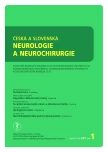The Determination of Serum and Cerebrospinal Fluid Clusterine Utilized in the Diagnostics of the CNS Affection – A Pilot Study
Authors:
D. Stejskal 1; J. Vavroušková 2; J. Mareš 3; M. Karpíšek 4
Authors‘ workplace:
Oddělení laboratorní medicíny Nemocnice Šternberk p. o.
1; Neurologické oddělení Nemocnice Šternberk p. o.
2; Neurologická klinika FN Olomouc
3; Veterinární a farmakologická fakulta Brno
4
Published in:
Cesk Slov Neurol N 2007; 70/103(1): 62-66
Category:
Short Communication
Overview
Recently, there has appeared information concerning the possibility of determining the presence and extent of the brain disorder by means of examining selected parameters in the cerebrospinal fluid (CSF) or blood. One of these potential indices could be clusterine, an apoptosis inhibitor.
The study was aimed at the determination of the diagnostic effectiveness of examining clusterine in serum and CSF of patients with their CNS involvement.
Thirty-eight probands underwent the examination. The subjects were divided into two groups according to the presence of the CNS affection due to various causes (without/with involvement). Cerebral CT examination, lumbar puncture with morphological and biochemical investigations of CSF and determining the indices of albumins, immunoglobulins, cystatine and clusterine were carried out in all the probands. Subjects with signs of the CNS involvement showed higher concentrations of clusterine in CSF and its index in comparison with probands without the CNS affection (medians of clusterine, or index Csf/S 5760 vs 3435, p = 0.034 vs 0.023, p < 0.01). There were revealed significant correlations between CSF clusterine and indices of albumin (r = 0.58, p = 0.021), immunoglobulin G (r = 0.66, p = 0.008), immunoglobulin M (r = 0.24, p = 0.047), immunoglobulin A (r = 0.66, p = 0.008), and cystatine C in CSF ( r = 0.43, p = 0.022). After the classification of patients based on the presence of CNS disorder, it was found out that the determination of clusterine in CSF had the sensitivity of 79 % and specificity of 86 % at the value of clusterine > 4230 kU/l, and the sensitivity of clusterine index was 65 % and specificity 93 % at the value > 0.03 kU/l.
Clusterine seems to be a promising laboratory index of a damage to the brain cells with satisfactory diagnostic effectiveness. After verifying these data in larger trials, it could be used even in routine diagnostics.
Key-words:
clusterine, clusterine index, brain disorder, liquor, serum
Sources
1. Imhof A, Charnay Y, Vallet PG et al. Sustained astrocytic clusterin expression improves remodeling after brain ischemia. Neurobiol Dis 2006; 87: 117-21.
2. Van Beek J, Chan P, Bernaudin M et al. Glial responses, clusterin, and complement in permanent focal cerebral ischemia in the mouse. Glia 2000; 31: 39-50.
3. Martin-Rehrmann MD, Hoe HS, Capuani EM et al. Association of apolipoprotein J-positive beta-amyloid plaques with dystrophic neurites in Alzheimer's disease brain. Neurotox Res 2005; 7: 231-42.
4. Stejskal D, Vavroušková J, Mareš J et al. Application of new laboratory marker assays in neurological diagnosis - a pilot study. Biomedical Papers 2005; 149: 265-7.
5. Silkensen J. Clusterin: physiologic and pathophysiologic considerations. Int J Biochem Cell Biol 1995; 27: 633-45.
6. Kim BM, Kim SY, Lee S, Shin YJ, Min BH, Bendayan M et al. Clusterin induces differentiation of pancreatic duct cells into insulin-secreting cells. Diabetologia 2006; 49: 311-20.
7. Gleave ME, Gleave J, Burt HM. The inhibition of angiogenesis by antisense oligonucleotides to clusterin. Angiogenesis 2005; 8: 229-38.
8. Kruger S, Mahnken A, Kausch I et al. Value of clusterin immunoreactivity as a predictive factor in muscle-invasive urothelial bladder carcinoma. Urology 2006; 67: 105-9.
9. Strocchi P, Smith MA, Perry G et al. Clusterin up-regulation following sub-lethal oxidative stress and lipid peroxidation in human neuroblastoma cells. Neurobiol Aging 2006; 4: 87-91.
10. Iwata A, Browne KD, Chen XH et al. Traumatic brain injury induces biphasic upregulation of ApoE and ApoJ protein in rats. J Neurosci Res 2005; 82: 103-14.
11. Holtzman DM. In vivo effects of ApoE and clusterin on amyloid-beta metabolism and neuropathology. J Mol Neurosci 2004; 23: 247-54.
12. Lidstrom AM, Hesse C, Rosengren L et al. Normal levels of clusterin in cerebrospinal fluid in Alzheimer's disease, and no change after acute ischemic stroke. J Alzheimers Dis 2001; 3: 435-42.
13. Sasaki K, Dohura K, Ironside JW et al. Increased clusterin (apolipoprotein J) expression in human and mouse brains infected with transmissible spongiform encephalopathies. Acta Neuropathol 2002; 103: 199-208.
Labels
Paediatric neurology Neurosurgery NeurologyArticle was published in
Czech and Slovak Neurology and Neurosurgery

2007 Issue 1
- Metamizole vs. Tramadol in Postoperative Analgesia
- Memantine in Dementia Therapy – Current Findings and Possible Future Applications
- Memantine Eases Daily Life for Patients and Caregivers
- Metamizole at a Glance and in Practice – Effective Non-Opioid Analgesic for All Ages
- Advances in the Treatment of Myasthenia Gravis on the Horizon
Most read in this issue
- Panic Disorder – Neuropsychiatric Profile
- The Liquor Tau Protein and Beta Amyloid in Alzheimer’s Disease
- Diagnosis and treatment of leptomeningeal carcinomatosis in solid tumors
- Surgical treatment of the metastatic cervical spine tumours
